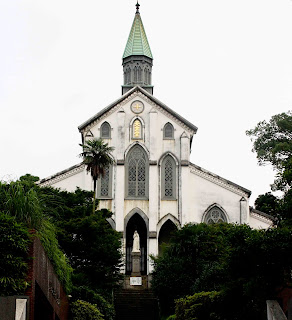Hot ginger and dynamite There's nothing but that at night
Back in Nagasaki
Where the fellers chew tobaccy
And the women wicky-wacky
Woo
I went to Nagasaki expecting the main story of the place to be the atomic bomb. Instead, I found Madam Butterfly.
I am currently reading The Thousand Autumns of Jacob de Zoet by David Mitchell. It is excellent and a very useful insight into the history of Nagasaki. For decades, Japan was closed to all Westerners and and Western influences. Contact was limited to employees of the Dutch East India Company who were restricted to a small island connected by bridge to nagasaki.
In the 19th century, a few Europeans were allowed to move into an enclave in Nagasaki proper and, even, to practise Christianity, forbidden to the Japanese. When some locals came forward and announced that they were Christians, their forebears converted by Francis Xavier, they were exiled from the city, though eventually allowed back.
Nagasaki today is where Japanese people go to see the remnants of the European colonial lifestyle. There are a few European houses preserved on the so-called Dutch Slope,

a Catholic church (the first I saw in Japan),

and Glover Garden.

This is a a visitor attraction built around half a dozen European-style houses dating from the late 19th century for prominent European businessmen. Many of them married or lived with Japanese women. This is their excuse, I suppose (oh, okay, and the fact that the opera is set in Nagasaki) to have a statue of Puccini,

tributes to various singers who’ve sung in Madam Butterfly, and Un Bel Di piped out of multiple locations. From what I remember, the Humming Chorus in the opera is meant to be the birdies and the bees singing in the garden - but I don't remember any reference to loudspeakers hidden in the trees....

I was very taken with the escalators that whisk you up the hillside, though it does lend a distinctly Disney air to the proceedings.

The houses were well-kept, though in the humidity of Nagasaki in early July, the furniture and décor looked very heavy and a bit out of place.

This is Thomas Glover’s house.

From Scotland, he came to Nagasaki and established several successful businesses, married a Japanese woman and had several children with her.
And here’s an image that shows old Nagasaki with the new, thriving harbour:

That view looks over to the North, where the atomic bomb fell. I did see the site and read some of the descriptions of the bombing, all horrific and terribly, terribly sad. But, like I said, there’s more to Nagasaki than that story and I was delighted, if surprised, by how much I loved exploring the city.









I hope you hastened to mass.
ReplyDeleteThis is a Travel Blog. Met Mitchell few weeks ago and his book is waiting as next read. Japan fascinating from the telling. Hate to risk negating other posts through effusiveness but particularly loved this one. Hope Australia is treating you well.
ReplyDelete